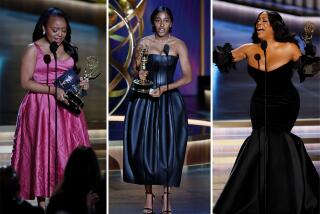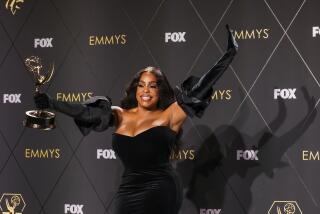Unlike Oscars, 2015 Emmys have diverse shows, actors to recognize
While the Oscars were largely a dry white straight male season, the Emmys are shaping up to be anything but, with acclaimed shows starring women, people of color and characters of various sexual and/or gender orientations. The list of newcomers breaking some rare ground is impressive: “Jane the Virgin,” “The Nightly Show,” “black-ish,” “Empire,” “Fresh Off the Boat,” “How to Get Away With Murder,” “Cristela” and “Transparent.”
They join longer-running shows, including “Orange Is the New Black,” “The Mindy Project,” “Being Mary Jane,” “Power,” “Scandal” and “Looking,” in giving the audience characters and stories from communities that were previously all but invisible on television.
One of the champions of the “normalizing” of TV — the term she prefers over “diversity” — is Shonda Rhimes. Her three ABC shows do so, starting with colorblind casting for “Grey’s Anatomy.” “Scandal” was the first network drama in 30 years to star a black woman. The newest Shondaland entry, “How to Get Away With Murder,” stars Viola Davis, who won a Golden Globe for her role.
“When people say Shonda has revolutionized TV — and I completely agree that she has — it started with that simple act of wanting the best actor for the part, because then you end up with Viola Davis,” says Peter Nowalk, “Murder’s” creator.
“Shonda certainly trailblazed a lot of this current move in so many different ways,” says Larry Wilmore. An executive producer of ABC’s “black-ish” until he was tapped to host Comedy Central’s “Nightly Show,” Wilmore has been working to increase inclusion for years. As a Writers Guild board member, “I was on some diversity committees there, working behind the scenes trying to make these things happen, so it’s nice to see them turning around.”
Mara Brock Akil has been another longtime force for change. Creator of the long-running sitcom “Girlfriends,” her latest show is a drama, BET’s “Being Mary Jane,” starring Gabrielle Union as a successful news anchor with a complicated personal and family life. “Even though it’s a black family, it’s an American family,” Akil says. “The through-line is the universality.”
Even more welcome than these characters’ growing visibility is their growing complexity. “There’s a tendency to cast women of color in roles that are nurturing, likable, earthy and maternal,” says Davis. “Shondaland is not a proponent of any of those stereotypes, so what they’ve allowed me to do is kind of redefine what it means to play a black female character on television, who’s 49 and my hue and my size.”
Kenya Barris, “black-ish” creator, credits ABC for being “diligent in letting us do issue-related comedy. It sort of hearkens back to the time of Norman Lear, when comedy actually opened up conversations.”
That broadening of scope is also embraced by Randall Park, star of ABC’s comedy “Fresh Off the Boat,” a show about an immigrant Taiwanese family. “The great thing about a lot of these shows is that race is a part of the characters’ lives, but it’s not the sole thing that defines them,” Park says.
“Boat” is the first Asian American network series to air in 20 years, since Margaret Cho’s “All-American Girl,” and the pressure is intense. “Many times the groups get punished when they’re not successful,” says Wilmore. “Margaret Cho’s show didn’t work, so it was like, ‘I guess Koreans can’t be funny.’ No, that show just didn’t work.”
HBO’s “Looking,” the only show on television to have gay male characters in all the lead roles, also has two Latino characters, and they don’t get along particularly well. “Historically, American TV shows and media haven’t been too skilled at recognizing all the diversity within minority groups,” says creator Michael Lannan, regarding such umbrella groups as Latino or Asian. “What we’re seeing now is that those specific details are getting more recognition, and as the culture moves forward I think we’re going to see more of that.”
Gina Rodriguez, Golden Globe winner for her star turn in the CW’s “Jane the Virgin,” believes unity is key to greater representation. “Even if a 10th of the 54 million-plus Latinos [in the U.S.] watch ‘Jane,’ then you best believe the CW is going to put another show on and it’s going to be about a Mexican girl, and then another with a Guatemalan guy,” she says.
But it’s not just a matter of putting new faces on the screen, all seem to agree.
Nowalk cites the smash success of Fox’s “Empire” as an example of what does work: “Tell stories that feel fresh and new, and give us access to worlds that we’re not seeing on TV. Originality is always going to win out.”
Akil credits the audience for its maturity. “The generation now watching TV knows storytelling far better than we did. It has to get more nuanced, more specific, to be engaging.” Adds Wilmore, “I know that TV tends to be cyclical, but I’m hoping that this isn’t one of the cycles, that this opens the door for more groups that we don’t get to hear from.”
The goal is for inclusion to be such a matter of course that it doesn’t merit notice, “to just be recognized for being a great show, as opposed to the one Asian show,” says Park.
Adds Barris, “When I start doing panels, and it’s not about being a black show runner, that’s the win.”
More to Read
From the Oscars to the Emmys.
Get the Envelope newsletter for exclusive awards season coverage, behind-the-scenes stories from the Envelope podcast and columnist Glenn Whipp’s must-read analysis.
You may occasionally receive promotional content from the Los Angeles Times.






